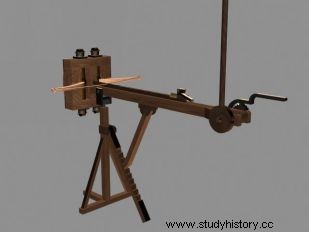
The scorpion (also known as the ballista when it launched balls) was a catapult with arrows, probably invented by the Greeks and then adopted and used on a large scale by the Roman legions. Unlike a bow that works by twisting its arms, the scorpion used a torsion spring system to obtain a very high power for the arms and therefore a high ejection speed for the arrows. This torsion could be adjusted at four points of the weapon using a special key to increase range, power or precision. During the Late Republican period and under the High Empire, there were 60 scorpions per legion (one per century, there were 60 centuries, 5120 soldiers in all), this catapult with arrows had two main functions:
* in straight shooting, it was a sniper weapon capable up to a distance of 100 m to shoot down an enemy target. Caesar in his Gallic Wars even describes the terrifying precision of the scorpions during the
siege of Avaricum, it was the ancestor of our sniper rifles.
* in parabolic firing, the firing range is much greater, probably up to 400 m, the firing rate is higher (5 to 6 rounds per minute, tested by reenactors) but the accuracy is much lower. The scorpions are used in "battery" at the top of a hill whose flank is protected by the legion. In this case, 60 scorpions can shoot up to 300 arrows per minute at the enemy army. The bolt's weight and speed are sufficient to pierce enemy shields and injure or kill warriors using them. Reenactors have tested this power on crash test dummies, and the penetration power is three men at 300 meters...
The complexity of construction and adjustment and the great sensitivity to temperature and humidity variations limited the use of torsion spring catapults that the Romans called "tormenta". Moreover, this type of technology disappeared from the high Middle Ages (with the exception of the Byzantine Empire) giving way from the first crusades to a new type of catapult based on a system of slings and counterweights which will give birth to the spectacular trebuchet for the projection of stone balls or giant crossbows (thanks to the progress made in the field of metallurgy) for the projection of giant lines. This weapon of remarkable precision and power was particularly feared by the enemies of Rome.
